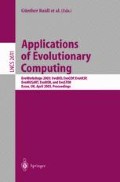Abstract
This paper describes a domain independent approach to the use of genetic programming for object detection problems. Rather than using raw pixels or high level domain specific features, this approach uses domain independent statistical features as terminals in genetic programming. Besides position invariant statistics such as mean and standard deviation, this approach also uses position dependent pixel statistics such as moments and local region statistics as terminals. Based on an existing fitness function which uses linear combination of detection rate and false alarm rate, we introduce a new measure called “false alarm area” to the fitness function. In addition to the standard arithmetic operators, this approach also uses a conditional operator ifin the function set. This approach is tested on two object detection problems. The experiments suggest that position dependent pixel statistics computed from local (central) regions and nonlinear condition functions are effective to object detection problems. Fitness functions with false alarm area can reflect the smoothness of evolved genetic programs. This approach works well for the detecting small regular multiple class objects on a relatively uncluttered background.
Access this chapter
Tax calculation will be finalised at checkout
Purchases are for personal use only
Preview
Unable to display preview. Download preview PDF.
References
Paul D. Gader, Joseph R. Miramonti, Yonggwan Won, and Patrick Coffield. Segmentation free shared weight neural networks for automatic vehicle detection. Neural Networks, 8(9):1457–1473, 1995.
Daniel Howard, Simon C. Roberts, and Richard Brankin. Target detection in SAR imagery by genetic programming. Advances in Engineering Software, 30:303–311, 1999.
Walter Alden Tackett. Genetic programming for feature discovery and image discrimination. In Stephanie Forrest, editor, Proceedings of the 5th International Conference on Genetic Algorithms, ICGA-93, pages 303–309, University of Illinois at Urbana-Champaign, 17–21 July 1993. Morgan Kaufmann.
Karl Benson. Evolving finite state machines with embedded genetic programming for automatic target detection within SAR imagery. In Proceedings of the 2000 Congress on Evolutionary Computation CEC00, pages 1543–1549, La Jolla Marriott Hotel La Jolla, California, USA, 6–9 July 2000. IEEE Press.
Cristopher T. M. Graae, Peter Nordin, and Mats Nordahl. Stereoscopic vision for a humanoid robot using genetic programming. In Stefano Cagnoni, Riccardo Poli, George D. Smith, David Corne, Martin Oates, Emma Hart, Pier Luca Lanzi, Egbert Jan Willem, Yun Li, Ben Paechter, and Terence C. Fogarty, editors, Real-World Applications of lutionary Computing, volume 1803 of LNCS, pages 12–21, Edinburgh, 17 April 2000. Springer-Verlag.
Daniel Howard, Simon C. Roberts, and Conor Ryan. The boru data crawler for bject detection tasks in machine vision. In Stefano Cagnoni, Jens Gottlieb, Emma Hart, Martin Middendorf, and Günther Raidl, editors, Applications of Evolutionary Computing, Proceedings of EvoWorkshops2002: EvoCOP, EvoIASP, EvoSTim, volume 2279 of LNCS, pages 220–230, Kinsale, Ireland, 3–4 April 2002. Springer-Verlag.
F. Lindblad, P. Nordin, and K. Wol.. Evolving 3d model interpretation of images using graphics hardware. In Proceedings of the 2002 IEEE Congress on Evolutionary Computation, CEC2002, Honolulu, Hawaii, 2002.
Jamie R. Sherrah, Robert E. Bogner, and Abdesselam Bouzerdoum. The evolutionary pre-processor: Automatic feature extraction for supervised classification using genetic programming. In John R. Koza, Kalyanmoy Deb, Marco Dorigo, David B. Fogel, Max Garzon, Hitoshi Iba, and Rick L. Riolo, editors, Genetic Programming 1997: Proceedings of the Second Annual Conference, pages 304–312,Stanford University, CA, USA, 13–16 July 1997. Morgan Kaufmann.
Mengjie Zhang and Victor Ciesielski. Genetic programming for multiple class object detection. In Norman Foo, editor, Proceedings of the 12th Australian Joint Conference on Artificial Intelligence (AI’99), pages 180–192, Sydney, Australia, December 1999. Springer-Verlag Berlin Heidelberg. Lecture Notes in Artificial Intelligence (LNAI Volume 1747).
Mengjie Zhang, Victor Ciesielski, and Peter Andreae. A domain independent approach to multiclass object detection using genetic programming. Technical Report CS-TR-02-4, Victoria University of Wellington, April 2002.
Riccardo Poli. Genetic programming for feature detection and image segmentation. In T. C. Fogarty, editor, Evolutionary Computing, number 1143 in Lecture Notes in Computer Science, pages 110–125. Springer-Verlag, University of Sussex, UK, 1–2 April 1996.
Riccardo Poli. Genetic programming for image analysis. In John R. Koza, David E. Goldberg, David B. Fogel, and Rick L. Riolo, editors, Genetic Programming 1996: Proceedings of the First Annual Conference, pages 363–368, Stanford University, CA, USA, 28–31 July 1996. MIT Press.
Author information
Authors and Affiliations
Editor information
Editors and Affiliations
Rights and permissions
Copyright information
© 2003 Springer-Verlag Berlin Heidelberg
About this paper
Cite this paper
Zhang, M., Andreae, P., Pritchard, M. (2003). Pixel Statistics and False Alarm Area in Genetic Programming for Object Detection. In: Cagnoni, S., et al. Applications of Evolutionary Computing. EvoWorkshops 2003. Lecture Notes in Computer Science, vol 2611. Springer, Berlin, Heidelberg. https://doi.org/10.1007/3-540-36605-9_42
Download citation
DOI: https://doi.org/10.1007/3-540-36605-9_42
Published:
Publisher Name: Springer, Berlin, Heidelberg
Print ISBN: 978-3-540-00976-4
Online ISBN: 978-3-540-36605-8
eBook Packages: Springer Book Archive

